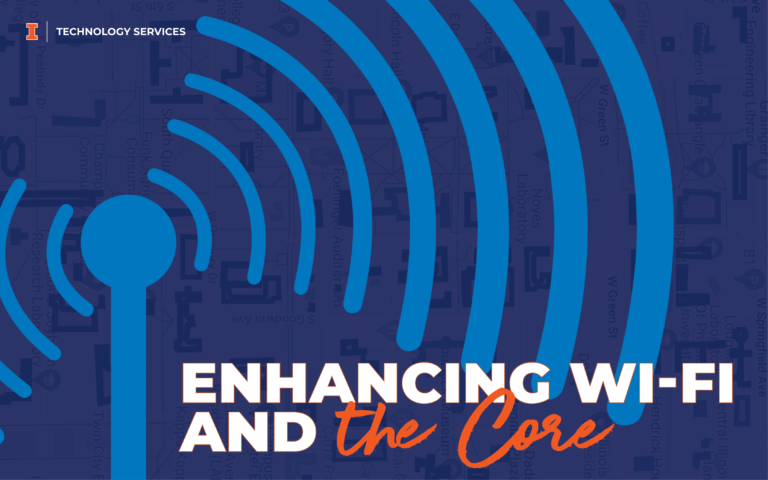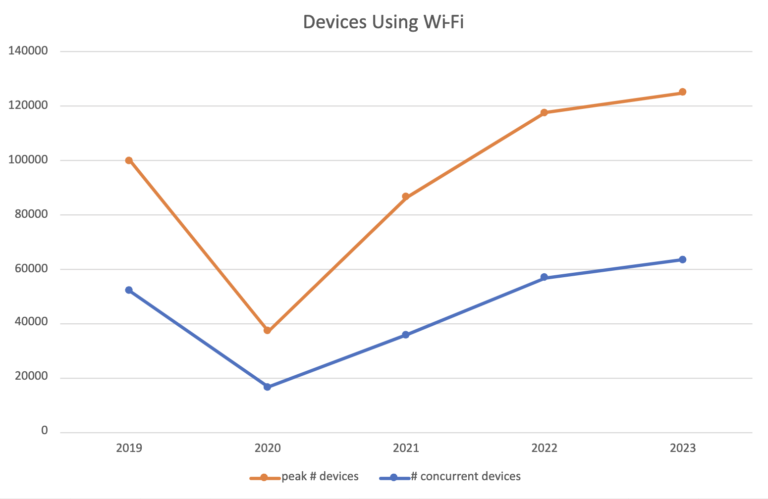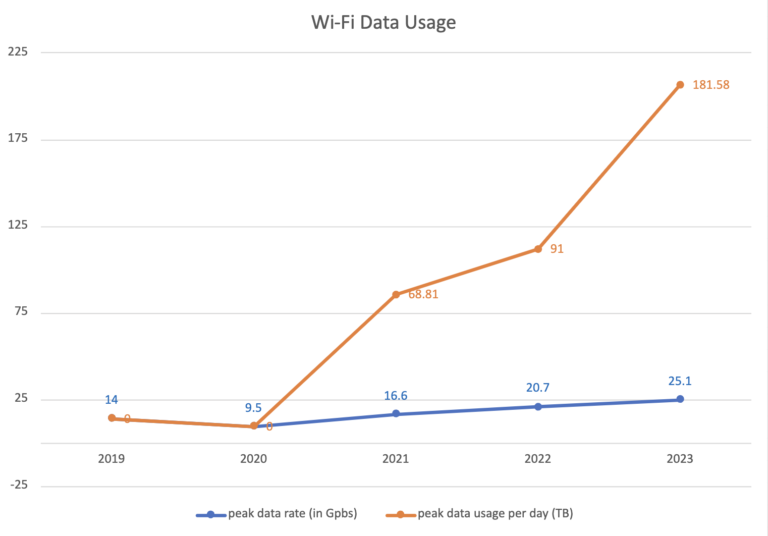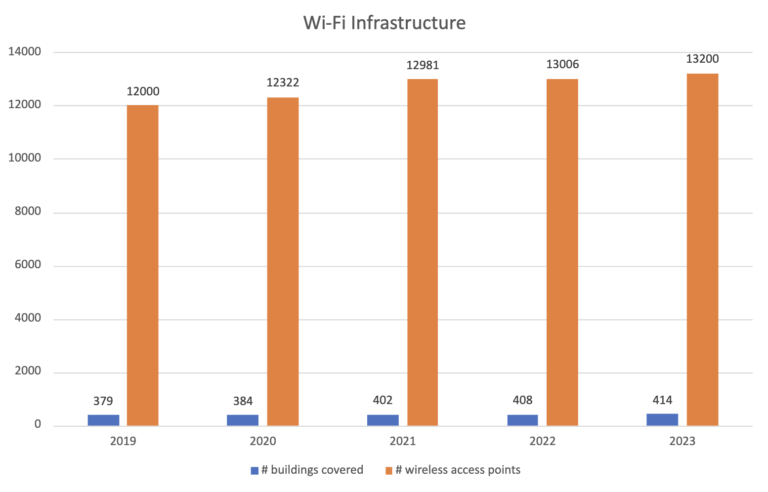
Over 13,000 Wireless Access Points (APs) provide Wi-Fi coverage to the university.
Campus Wi-Fi, known more commonly as IllinoisNet, has come a long way—and it is still improving. Technology Services is constantly hard at work to ensure campus networking functions at its best. During this past year, the university network, including IllinoisNet and wired connections, has undergone some significant upgrades.
The Great Wi-Fi Expansion
Since Summer 2022, Tech Services added 190 APs—physical devices that emit the Wi-Fi signal—to campus. Most of the APs were set up in the Carl R. Woese Institute for Genomic Biology (IGB) this fall, expanding IllinoisNet coverage throughout the building for the first time. A few others were added in various classrooms and in some libraries, increasing Wi-Fi coverage and capacity in those previously bottlenecked areas.
In addition to adding 190 APs, around 3,000 APs were replaced this year, enabling faster connections and better stability. With the exception of a couple hundred APs replaced in residence halls, many of the new and replaced indoor APs have 6GHz capability.
“With the newest Wi-Fi 6GHz technology, new channels and greater speed and capacity are possible,” said Chuck Hayes, Team Lead of Wireless Networking at Technology Services. “Besides the yearly refresh, we are constantly fine-tuning configurations and evaluating the performance of different areas.”
With the newer technology, larger amounts of data are being moved. Last year, 91 terabytes (TB) was moved in one day compared to this year, when over 181 TB was moved in one day. This means that after the past year’s changes, users have significantly more bandwidth.
The Wi-Fi expansion is still in progress. Currently, campus has over 400 buildings with connectivity, and the number is only growing—in bandwidth and speed.
“While most people aren’t carrying 6GHz-capable technology yet, some are and more will as they replace their phones over time,” said IT Infrastructure Director Brad Mahaffey. “We are trying to get everyone who has or will have the 6GHz technology to enable it on their device and move off our traditional 5GHz band. Users of the Campus Wi-Fi would see better service, particularly in high-density areas, after they make the transition from 5GHz.”
Devices that are Wi-Fi 6GHz capable will be labeled with Wi-Fi 6E and will automatically connect to Wi-Fi 6GHz without configuration.
Technology Services continues to partner with units to enhance and support wireless coverage across the university, including outdoor spaces. Looking to the future connectivity needs of the campus community, units are encouraged to share their goals by emailing consult@illinois.edu.
Besides the expansion, the recent network core upgrade brought further improvements.
Network Core Upgrade Secures Stronger Foundation
This past summer, Tech Services collaborated with our IT partners across campus to complete an entire core network upgrade.
The core is the foundation of all network connectivity across campus, directly affecting wired and Wi-Fi capabilities. If the network is compared to roads, the core is like the Interstate through which all traffic must flow, and the Wireless APs are like the side streets. The more lanes on the Interstate, the better the flow; the more side streets there are, the more avenues that traffic from the interstate can pass through.
“The new core capabilities enable networks with capacity and speeds way beyond our current need. We are trying to be ahead to avoid a future bottleneck,” said Mahaffey.
The new core more than doubles the network capabilities and reliability, preparing the university for long-term success.
Some Campus Wi-Fi History: Then and Now
Within the past decade, the university has gone from about 4,200 Wireless Access Points (APs) to 13,200.
In the early 2010s, the university endeavored to stay up-to-date with the increasing demand for network connectivity. There were a lot of people requesting connectivity where there wasn’t any, and a lot of buildings that needed to expand coverage to meet demand. With the increasing need, campus secured funding to cover all academic buildings, thus kicking off the project.
“Before the Wireless Expansion and Upgrade project, Wi-Fi coverage was mostly spot coverage; in other words, we did not typically cover an entire building. This led to some areas in buildings where students studied without network coverage, and many problem tickets we received were about that,” said Hayes.
“We were using an older technology that was slower and didn’t allow as many devices to connect simultaneously. It was also much harder to get devices onto the network. Now, we have a portal where users can register any kind of device–even Airplay-like ones,” said Hayes.
Debbie Fligor, Assistant Director of Network Services at Tech Services, also comments on how the Wi-Fi expansion has affected the campus community. “The biggest impact has probably been the ubiquitous connectivity. Now, it doesn’t matter where they are—in the Union or a classroom—they are connected when they want to be.”
Consequently, more instructors are able to host quizzes and exams online, inside, or outside the classroom. IllinoisNet also supports instructors leveraging functions such as Airplay to be more mobile within the classroom while enhancing teaching.
With the Wi-Fi expansion, connectivity is now accessible in all academic buildings. Hayes also added that with the Wi-Fi expansion, they took building capacity into account to know how much connectivity may be needed at one time instead of opting for minimal coverage in each building.
Since the Wireless Expansion and Upgrade Project kicked off in 2014, Technology Services has been hard at work bringing major updates to campus Wi-Fi, enabling faster download speeds, better video streaming quality, increasing data transfer rates, and more.
“If we have a mission,” said IT Infrastructure Director Brad Mahaffey, “it’s to be as reliable and stable as possible. Everything depends on the network, and when we shift it, everything else must shift as well. We want to be as boring, uninteresting, and overlooked as possible: stability and reliability are our key words.”


